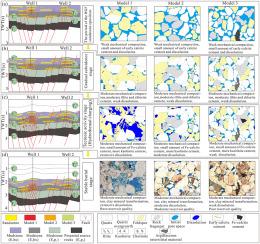东海盆地西湖凹陷南部渐新统花岗砂岩成岩作用及埋藏史控制:对有效储层形成的启示
IF 3.6
2区 地球科学
Q1 GEOSCIENCES, MULTIDISCIPLINARY
引用次数: 0
摘要
旨在揭示HY地区渐新统华岗组砂岩储层成岩演化序列及控制因素,预测优质储层分布,指导油气勘探。采用岩心观测、薄片岩石学、地球化学分析和地震测井解释相结合的综合方法。通过埋藏史模拟与成岩分析相结合,系统分析储层物性和成岩演化,建立有效储层孔隙空间演化模型。结果表明,E3h砂岩经历了压实、胶结和溶蚀等强烈成岩作用。成岩作用在控制储层质量方面起着至关重要的作用:压实作用是决定岩石物性垂直变化的主要因素,其中较浅的层段通常比较深的层段表现出更好的质量。相比之下,胶结作用和溶蚀作用是次要控制因素,这解释了A区块和B区块的物性差异,A区块的储层更优越。埋藏史与成岩作用有三个阶段的关系:(1)早期逐渐沉降阶段(GSS):弱长石溶蚀、早期碳酸盐胶结、绿泥石包覆、机械压实;(2)以大量长石溶蚀、石英过度生长沉淀、含铁胶结物形成为特征的构造活动中期;(3)以压实和粘土矿物转化强化为特征的晚期稳定埋藏阶段(SBS)。断裂系统和砂岩的空间构型及其组成属性对成岩演化具有重要的控制作用。在断裂带和酸性流体运移路径的交叉处出现有利于溶蚀发育的带,而石英-长石富集带通过抗压实作用减轻孔隙度损失。提出了高溶蚀-低胶结-低压实、中等溶蚀-低胶结-低压实、低压实-低胶结-低溶蚀3种有效的油藏开发模式。该研究为研究区E3h优质储层预测提供了重要依据。此外,本文提出的埋藏史-成岩作用综合分析方法,为类似地质环境下砂岩成岩演化研究和油气勘探提供了有价值的参考。本文章由计算机程序翻译,如有差异,请以英文原文为准。

Diagenesis and burial history controls on Oligocene Huagang sandstones, southern Xihu Sag (East China Sea Basin): Implications for the formation of effective reservoirs
This study aims to reveal the diagenetic evolution sequence and controlling factors of Oligocene Huagang Formation (E3h) sandstone reservoirs in the HY area, and predict high-quality reservoir distribution to guide hydrocarbon exploration. A comprehensive approach integrating core observation, thin-section petrography, geochemical analysis, and seismic-log interpretation was employed. By combining burial history simulation and diagenetic analysis, we systematically analyzed reservoir quality and diagenetic evolution and established evolution models for effective reservoir pore spaces. Results indicate that E3h sandstones underwent intense diagenetic processes including compaction, cementation, and dissolution. Diagenesis plays a critical role in controlling reservoir quality: compaction is the primary factor that governs vertical variations in petrophysical properties, where shallower intervals typically exhibit better quality than deeper ones. In contrast, cementation and dissolution serve as secondary controls, explaining property differences between Blocks A and B, with Block A reservoirs being superior. A three-stage relationship has been identified between burial history and diagenesis: (1) early gradual subsidence stage (GSS) with weak feldspar dissolution, early carbonate cementation, chlorite coating, and mechanical compaction; (2) intermediate tectonic activity stage (TAS) with massive feldspar dissolution, quartz overgrowth precipitation, and ferruginous cement formation; (3) late stable burial stage (SBS) featuring intensified compaction and clay mineral transformations. The spatial configuration of fault systems and sandstones, combined with compositional attributes, strongly controls diagenetic evolution. Favorable zones for dissolution development occur at intersections of fault zones and acidic fluid migration pathways, while quartz-feldspar-rich zones mitigate porosity loss via compaction resistance. Three effective reservoir development models were proposed: high dissolution-low cementation-low compaction, moderate dissolution-low cementation-low compaction, and low compaction-low cementation-low dissolution. This research provides a critical basis for predicting E3h high-quality reservoirs in the study area. Furthermore, the comprehensive burial history-diagenesis analysis method presented here offers a valuable reference for studies on sandstone diagenetic evolution and hydrocarbon exploration in similar geological settings.
求助全文
通过发布文献求助,成功后即可免费获取论文全文。
去求助
来源期刊

Marine and Petroleum Geology
地学-地球科学综合
CiteScore
8.80
自引率
14.30%
发文量
475
审稿时长
63 days
期刊介绍:
Marine and Petroleum Geology is the pre-eminent international forum for the exchange of multidisciplinary concepts, interpretations and techniques for all concerned with marine and petroleum geology in industry, government and academia. Rapid bimonthly publication allows early communications of papers or short communications to the geoscience community.
Marine and Petroleum Geology is essential reading for geologists, geophysicists and explorationists in industry, government and academia working in the following areas: marine geology; basin analysis and evaluation; organic geochemistry; reserve/resource estimation; seismic stratigraphy; thermal models of basic evolution; sedimentary geology; continental margins; geophysical interpretation; structural geology/tectonics; formation evaluation techniques; well logging.
 求助内容:
求助内容: 应助结果提醒方式:
应助结果提醒方式:


